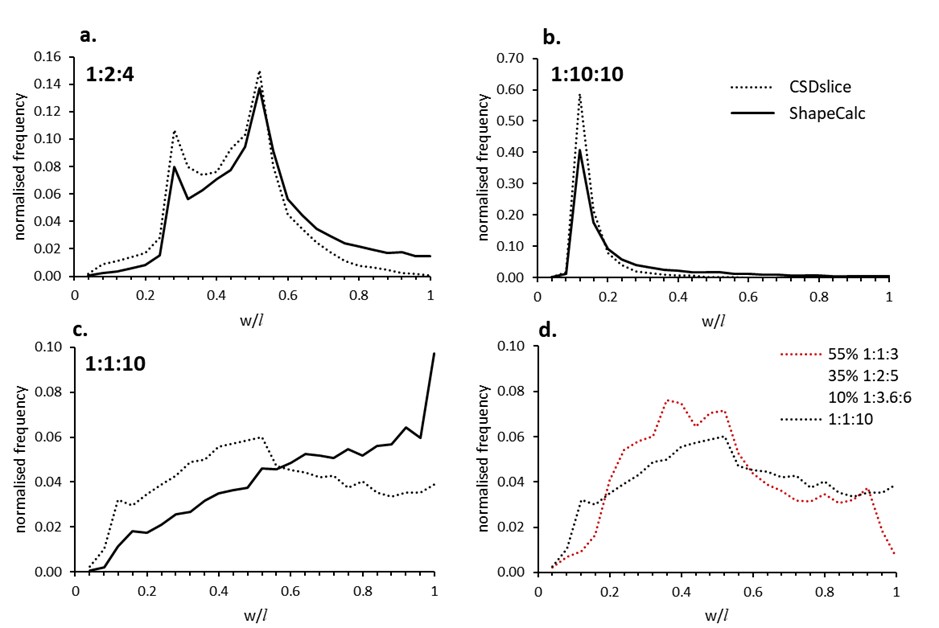Estimate 3D crystal shapes from 2D data – robustly and consistently
ShapeCalc is a free, Excel-based tool that estimates 3D crystal shapes from 2D intersection data — with greater accuracy and flexibility than previous methods.
The numbers, shapes and sizes of crystals in volcanic rocks are key to reconstructing magmatic processes such as magma storage, cooling and crystallisation as well as magma ascent. Crystal shape is an essential parameter in quantitative textural analysis techniques such as Crystal Size Distribution (CSD), a powerful method to reconstruct crystallisation histories.
Yet, estimating 3D crystal shapes from 2D thin sections can be complex and prone to errors. For example, cut-section effects demand statistical treatment and stereological projection of 2D data to estimate 3D crystal shapes. Existing tools such as CSDslice often yield inaccurate results, especially when dealing with natural crystals that vary in shape and size.
To address this challenge, we developed ShapeCalc.
ShapeCalc is the most robust tool to calculate 3D crystal shape from 2D textural data due to a range of unique features. ShapeCalc:
- Resolves a wider range of realistic crystal shapes than any other comparable tool
- Provides uncertainty estimates for each 3D shape solution
- Uses the same algorithms as CSDCorrections (Higgins, 2000), enabling internally consistent CSD workflows
Easy-to-Use and Accessible
ShapeCalc is designed for ease of use and can be run in Excel. All you need to provide are 2D crystal width and length measurements, which can be obtained using tools like ImageJ.
How ShapeCalc Works
ShapeCalc compares your 2D length and width data with 2D width-length distributions of randomly intersected 3D model shapes. By matching your data to these models, ShapeCalc generates estimates of the corresponding 3D aspect ratios and provides uncertainty metrics for each shape.
Watch this short walkthrough of ShapeCalc in action:
Why Use ShapeCalc?
Before the release of ShapeCalc, the most widely used tool for estimating 3D crystal shapes from 2D thin section data was CSDslice (Morgan & Jerram, 2006). Like ShapeCalc, CSDslice estimates 3D crystal shapes by comparing natural 2D width–length measurements with synthetic 2D distributions derived from 3D model shapes. However, ShapeCalc provides significantly more accurate and geologically meaningful results — particularly for samples containing multiple crystal populations with varying shapes and sizes, as is common in igneous rocks (Mangler et al., 2022).
In a direct comparison of synthetic 2D width–length distributions, CSDslice produces non-unique outputs for prismatic model shapes (e.g., short:intermediate dimension aspect ratio = 1:1). As a result, CSDslice cannot reliably distinguish between a single population of elongate crystals and a mixture of three populations with different shapes. This can lead to erroneous results — such as returning a dominant prismatic shape even when the real sample contains more complex or varied textures (see Panel d in the figure below).
 Fig: (a–c) Comparison of model 2D width/length distributions from CSDslice (dotted) and ShapeCalc (solid). Each is based on 10,000 (CSDslice) or 20,000 (ShapeCalc) random sections. (a) 1:2:4, (b) 1:10:10, (c) 1:1:10. Note the lack of a clear mode for the CSDslide distirbution, rendering it non-unique, as shown in (d) Mixing three CSDslice populations yields similar output to the 1:1:10 model, illustrating non-uniqueness and potential misinterpretation.
Fig: (a–c) Comparison of model 2D width/length distributions from CSDslice (dotted) and ShapeCalc (solid). Each is based on 10,000 (CSDslice) or 20,000 (ShapeCalc) random sections. (a) 1:2:4, (b) 1:10:10, (c) 1:1:10. Note the lack of a clear mode for the CSDslide distirbution, rendering it non-unique, as shown in (d) Mixing three CSDslice populations yields similar output to the 1:1:10 model, illustrating non-uniqueness and potential misinterpretation.
For detailed documentation, example datasets, and installation instructions, visit the ShapeCalc GitHub repository.
Further reading
Mangler et al., 2022 – Petrology & ShapeCalc benchmarking
Full documentation PDF
Get started
Download ShapeCalc
Questions or feedback? Open an issue or contact me
